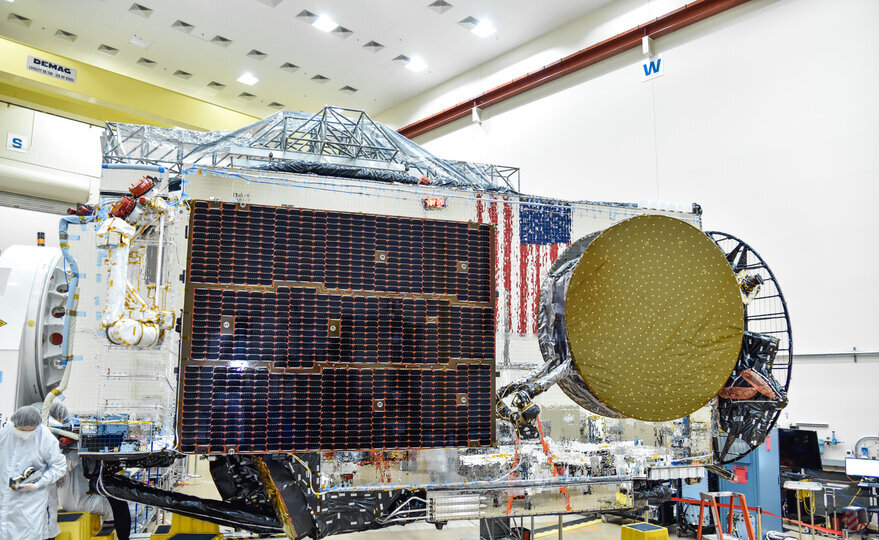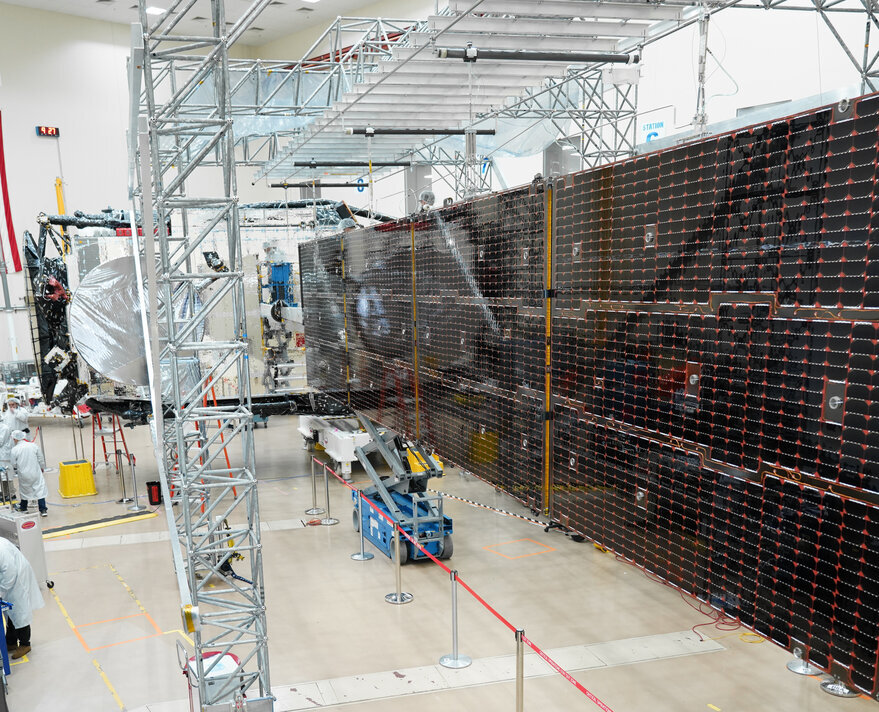11.03.2023
Hughes unveils Jupiter 3

PALO ALTO, Calif. — Hughes Network System unveiled Jupiter 3, a massive geostationary communications satellite built by Maxar Technologies.
While much of the industry focuses on packing increasing capability into small satellites, Jupiter 3 is a reminder large spacecraft remain important for certain applications.
With its antennas and solar panels stowed, Jupiter 3 is about the size of a standard school bus. The satellite, weighing roughly nine metric tons, is designed to offer 500 gigabit-per-second Ka-band capacity for North and South America.
“We have the ability to put all of that capacity down in that specified region,” Adrian Morris, Hughes Network Systems executive vice president of engineering, told SpaceNews. “These satellites are suitable for growing a market in a certain region.”

Jupiter 3 satellite solar array extended at Maxar Technologies manufacturing facility in Palo Alto, Calif. Credit: Hughes
Launch and Commissioning
On March 8, Maxar engineers and technicians were preparing to move Jupiter 3 to a vibration table. Environmental testing is one of the final steps before the satellite is shipped to Cape Canaveral Space Force Station in Florida for launch on a SpaceX Falcon Heavy rocket. No launch date has yet been announced, but Jupiter 3 is likely to fly in the second quarter of this year.
After commissioning is completed, Jupiter 3 will begin providing service from 95 degrees west in the third quarter, Hughes executives said March 8 during a press briefing at the Maxar facility here.
Jupiter 3 “will double the Echostar-Hughes fleet capacity when it goes into operations in that orbital slot,” Morris said.
HughesNet, with more than a million subscribers, will be able to add hundreds of thousands of additional subscribers with Jupiter 3, said Mark Wymer, Hughes Network Systems senior vice president.
Waiting on Jupiter 3
When Echostar, Hughes’ parent company, ordered Jupiter 3 from Maxar in 2017, the satellite was expected to launch in 2021. Manufacturing took longer than expected largely due to the COVID-19 pandemic and extensive nonrecurring engineering work, Maxar official said.
Maxar is compensating Echostar for the delays under an amended contract announced in November.
“We’ve been waiting for this new satellite and the capacity that it brings for quite some time,” Wymer said.
New Products and Services
Hughes is seeing increasing demand for data and high-speed connectivity from customers working from home, accessing education from home and relying on e-commerce for deliveries.
“We’ve had to create products and services that meet their demands and needs,” Wymer said. “This satellite is going to bring to us 50-megabit per second, 100-megabit per second [download speeds] for people that live in underserved and unserved areas.”
Jupiter 3 also will allow Hughes to extend Wi-Fi networks in South America. Customers who visit a Wi-Fi hotspot can gain temporary access for a fee rather than subscribing to a monthly service.
“It allows for a more cost-effective and economical way for someone to get services as they need them,” Wymer said.
Throughout Latin America, Jupiter 3 will enable Hughes to provide backhaul for mobile network operators as well.
Ground Segment
Hughes has established an extensive ground network for Jupiter 3. Data will be uplinked from gateways to the satellite in V-band and downlinked from the satellite to gateways in Q-band.
“We will have much higher bandwidth at each gateway than we were able to achieve with just the Ka-band at those gateways” for Jupiter 1 and Jupiter 2, said Stan Kay, Hughes Network Systems vice president of advanced development.
Quelle: SN
----
Update: 13.04.2023
.


